Luxury Redefined
UP NEXT

Fashion
Inside the mind of Jonathan Anderson, fashion's creative polymath

Design
What color is 2022?

Style
Watch moment Miss Universe 2021 was crowned

Fashion
Supermodel opens up in her debut book

Fashion
Remember when Marilyn Monroe's white dress made movie history?

Fashion
Make your brand sustainable or risk being 'left out' says fashion designer

Architecture
The story behind Italy's most visited cultural site

Arts
'My house is like entering another universe'

Arts
Last of the samurai swordsmiths

Arts
Why music legends travel to this remote island

The art market has radically changed. Here's how to buy art today
SHARE
Written byJacqui Palumbo, CNN
For a long time, the art market was "a secret world of whispers" according to art advisor Kim Heirston, who started her career working in New York's downtown galleries three decades ago. Then, as an archivist for the late gallerist Robert Miller, she safeguarded and only shared materials that were critical to gallery sales, on request.
But today, starting a fine art collection is easier than ever, thanks to the internet, where many players in the art market now operate. Purchasing artworks isn't just for art experts or the wealthy collectors who can afford to hire them. Now, "you're able to get every bit of information," Heirston said in a phone interview.
Many artworks can be purchased or bid for online, bypassing older models, such as directly negotiating with galleries or attending auctions.
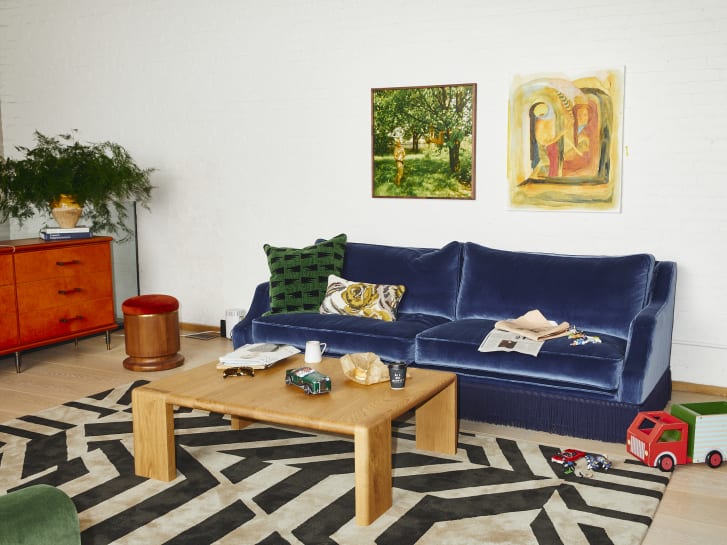
Artworks from Platform by Aneta Bartos (left) and Lucía Vidales (right). Credit: Jonathan Hökklo @hawkclaw/Platform
In 2019, Hiscox's annual art trade report captured the trend, estimating that online art sales had reached $4.8 billion that year -- up from $1.5 billion in 2013. The figure is expected to climb to $9.32 billion by 2024.
The coronavirus pandemic has spurred on significant changes as well -- from major auction houses like Christie's and Sotheby's experimenting with hybrid live and digital sales, and galleries and art fairs adapting to virtual showrooms. There's also been the meteoric rise of the digital art market mostly thanks to NFTs (non-fungible tokens).
But that said, those who are able and interested in purchasing artworks for tens or hundreds of thousands of dollars (or more), hiring an art advisor to guide your collection and counsel you on the art market is probably still wise.
"I've been able to see the vicissitudes," Heirston said. "I know who's in favor and who's not. I try to project who may be favored or coveted down the line."
But for first-time buyers or newcomers with a more modest budget -- say, in the hundreds or thousands -- they'll find there are many new ways to get started.
How to buy art online
Online art marketplaces offer a number of tools to help you get a grasp on the market, from robust search features and extensive pricing data to informative articles to help put the artists and artworks in context.
Artsy, founded in 2009, remains the largest marketplace, with an inventory of over 1 million artworks from more than 4,000 galleries, art fairs and institutions [disclaimer: this writer was a former employee at Artsy], but sites including Artsper and Saatchi Art also offer plenty of options. Users to these platforms won't necessarily be able to click-to-buy all listed artworks -- with some, you'll have to make online offers or contact the gallery. Both Artsy and Artnet also partner with auction houses and other organizations to offer exclusive online auctions.
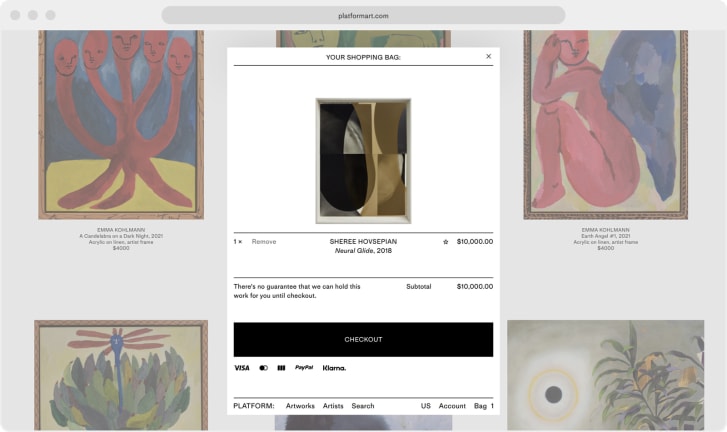
A view of Platform's marketplace. Credit: Platform
So, where might someone start? As a rule of thumb, prints, works on paper, photography and digital art often offer more reasonable price points than painting or sculpture. In addition, following the market of early-career artists can mean finding a great piece of art before their works become too pricey.
With seemingly endless listings, however, the question becomes how to sort through them all.
That's where Platform has stepped up, The David Zwirner-backed marketplace curates only 100 contemporary works each month from independent galleries around the US. General manager Bettina Huang says their model is similar to Net-a-Porter, which offers edits of luxury fashion and beauty offerings, "and then makes it really, really easy for you to buy."
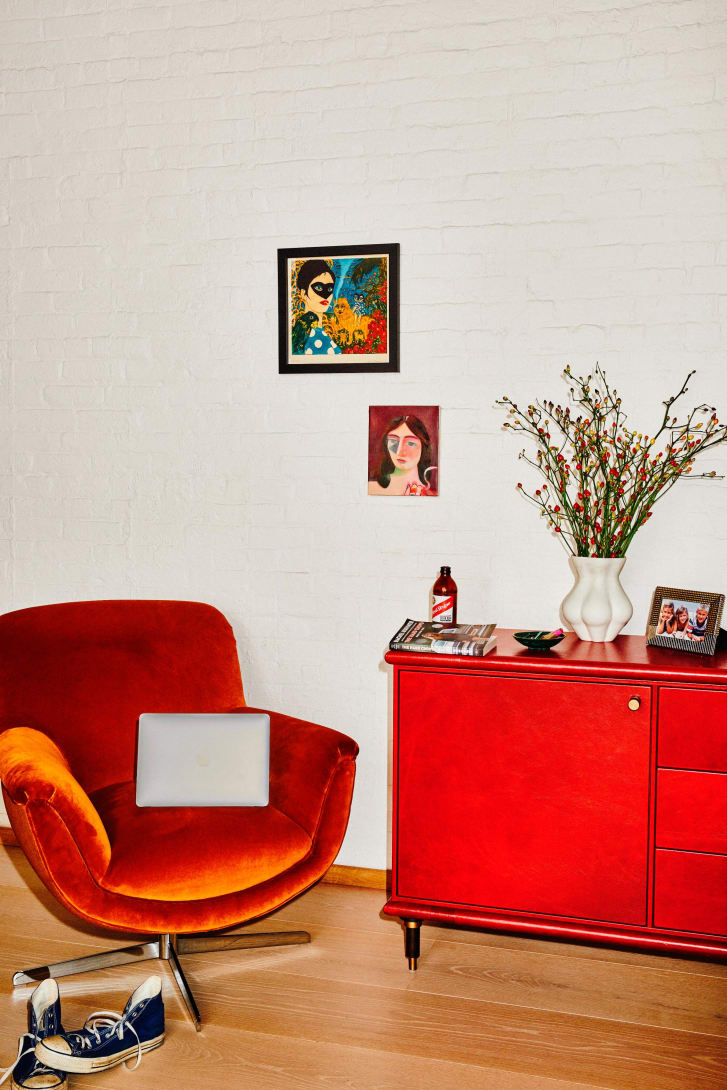
Artworks on Platform by Marcel Dzama (top) and Danielle Orchard (bottom). Credit: Jonathan Hökklo @hawkclaw/Platform
After the mega gallery David Zwirner partnered with smaller galleries to launch a series of viewing rooms while the pandemic shuttered galleries and halted their sales, Zwirner's son, Lucas, turned the project into its own art e-commerce company with Huang and a separate team. Platform offers many works under $10,000, and all can be directly purchased through the site (even in installments through Klarna). It's first-come, first-serve -- unlike many galleries, which can require intensive relationship-building -- though there is a loyalty program for repeat buyers to gain 24-hour early access each month.
"By limiting it to a certain number of artworks that are really vetted by the galleries whom we've specifically invited on, it's a very different approach so that as a consumer or collector, you can feel really confident that whatever you're buying has gone through multiple layers of checking," said Lucas Zwirner in the video call with Huang. "Our aspiration with Platform is to present a really diverse, accurate snapshot of the very best of what's out there."
How to lease-to-own
Buying expensive artwork isn't a snap decision for most people, which is why Parlor, a company that launched in 2020 is operating on a try-it-before-you-buy-it model, signing on galleries to offer monthly installments that go towards the total cost of a work.
Parlor users only have to be lightly committed, signing up for a 3- to 12-month lease, with the option to renew, purchase or swap for a new piece at the end. If an artist's market value happens to rise over the course of the lease period, the cost of the artwork will not go up -- though if someone else wishes to purchase the artwork during the lease period, the galleries reserve the right to sell it. Parlor handles installation and insurance, and also offers guidance on how to build a collection.
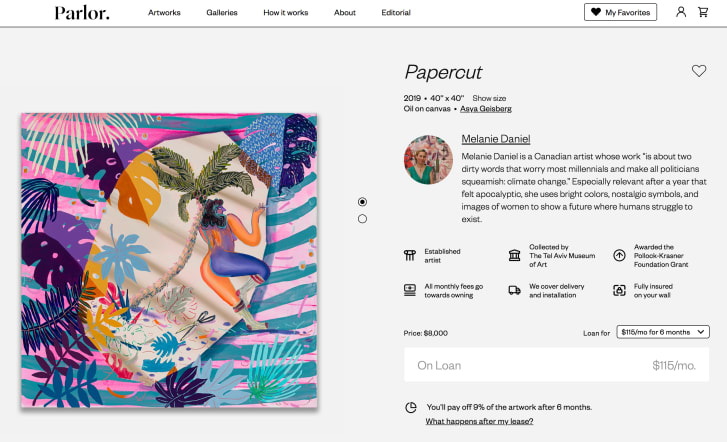
A view of Parlor's website. Credit: Parlor
"Buying art is hard...most people don't really know what they want, because they haven't really lived with art," Parlor's co-founder and CEO Julian Siegelmann said in a video call.
"Most (people) don't drop multiple thousands of dollars within galleries or fairs. So for us, it's really about...reducing the financial barriers, taking care of the logistical headache, and then also offering advisory services."
Though some of the works listed on Parlor can reach upwards of $50,000, Siegelmann says they are mostly focused on offering works of art under $20,000. (Works under $10,000 generally cost $85 a month for a 12-month lease). And the company's inventory is not only limited to what's on their site -- they've recently launched a request feature where you can send them artworks you're interested in while browsing at galleries or art fairs, and they'll reach out on your behalf.
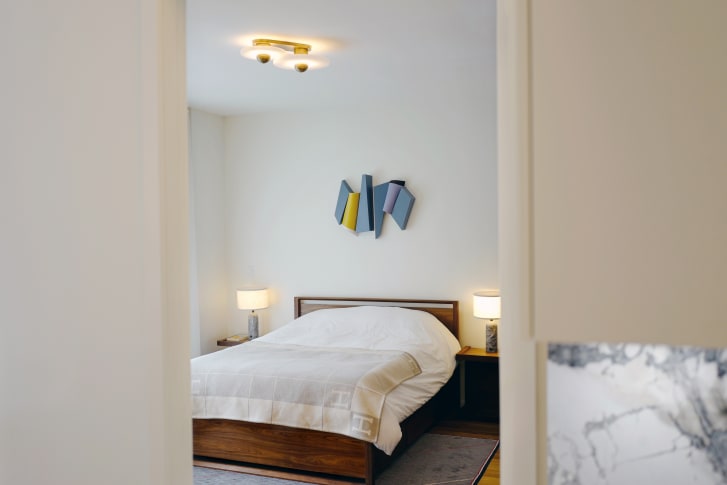
A Parlor collector's home featuring "Flow (Buckley)" by Henrik Eiben from Pablo's Birthday. Credit: Mark Rosen/Parlor
Parlor's marketing manager Kaitlin Macholz, who came to the company from Christie's, said that living with a piece first is the best way to make sure you want to keep it long-term.
"Sometimes you have a really different reaction to seeing an artwork in person rather than seeing it online," she said. "Things like scale or texture that might not always be visible online...Having it actually hanging above your couch or above your bed might totally change the way you look at that artwork and at the space."
How to collect digital art
One of the biggest shifts in the industry has occurred in the digital realm, with the emergence of non-fungible tokens, or NFTs. NFTs act like virtual signatures that use blockchain technology, giving digital creators the ability to prove their work is the original file. (NFTs can be made out of any digital file -- virtual fashion, event tickets, memes -- meaning the technology has also impacted much more than just the visual arts.)
Merel van Helsdingen, founder and managing director of Amsterdam's new-media focused Nxt Museum -- and a digital art collector herself -- says that NFTs have demolished the barriers for who gets to sell their work as an artist. The physical art world is "all very highly curated and controlled by the big auction houses, the bigger galleries and institutions," she said in a video interview.
NFTs, on the other hand, are sold largely outside the confines of traditional art spaces, on newer or exclusive e-commerce platforms which don't distinguish whether an artist is a "blue chip" or represented by an esteemed gallery.

Foundation
"It's open for everyone, if you have an email address and a cryptocurrency wallet, but you don't even need (a wallet) everywhere," she said. (She does recommend a Rainbow wallet for safekeeping your collections as well as your coins.)
That doesn't mean major auction houses haven't gotten on board -- this past March's eye-watering $69 million Beeple sale at Christie's cemented the marketability of NFTs in the art world.
One of the biggest benefits of artists using NFTs is that they automatically make a percentage of each new sale of their artworks, in contrast to traditional auctions where artists' works can sell for millions and they don't see a dime. Collectors know that each resale is benefiting the creator.
But the market is also prone to "a lot of hype," van Helsdingen said, with competitive, rapid bidding for limited editions, an intrinsic unpredictability, and unfortunately, hacks and scams. (It's also environmentally unfriendly due to the energy requirements of mining and transacting, though many crypto projects and NFT platforms have been aiming to reduce their ecological footprint, van Helsdingen notes.)
As for showing your NFT collection, you can do so on any digital display, but the virtual world is bound to offer more options soon, she said, like displaying your artworks within video games or through extended reality (XR) apps.
Top image: A Parlor collector's living room featuring "Mantle" by Zach Bruder from Magenta Plains.

